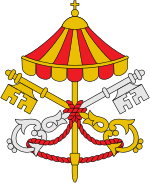Papal election, 1292–1294

Coat of arms during the vacancy of the Holy See
|
|
| Dates and location | |
|---|---|
| 5 April 1292 – 5 July 1294 Basilica di Santa Maria Maggiore, Rome Santa Maria sopra Minerva, Rome Perugia |
|
| Key officials | |
| Dean | Latino Malabranca Orsini |
| Camerlengo | Pietro Peregrosso |
| Protopriest |
Jean Cholet Benedetto Caetani |
| Protodeacon | Matteo Orsini Rosso |
| Elected Pope | |
|
Pietro de Morrone (Name taken: Celestine V) |
|
 |
|
The papal election from April 5, 1292 to July 5, 1294 was the last papal election which did not take the form of a papal conclave (in which the electors are locked in seclusion cum clave—Latin for "with a key"—and not permitted to leave until a new Bishop of Rome has been elected). After the death of Pope Nicholas IV on April 4, 1292, the eleven surviving cardinals (a twelfth died during the sede vacante) deliberated for more than two years before electing the third of six non-cardinals to be elected pope during the Later Middle Ages: Pietro da Morrone, who took the name Pope Celestine V.
Contemporary sources suggest that Morrone was hesitant to accept his election when word of the cardinals' decision reached his mountain-top hermitage. His ascetic life left him largely unprepared for the day-to-day responsibilities of the papacy, and he quickly fell under the influence of the Neapolitan monarchy of Charles of Anjou, to the dissatisfaction of even the pro-Angevin cardinals within the College. Celestine V resigned on 13 December 1294.
Twelve cardinal electors began the election, but one—Jean Cholet—died before it was completed.
The eleven electors were relatively evenly divided between the factions of Colonna and Orsini, two powerful Roman families, led by Giacomo Colonna and Matteo Orsini, respectively. The three Orsini cardinals were pro-French and pro-Angevin, while the two Colonna cardinals supported competing Aragonese claims in Sicily.James II of Aragon had bankrolled the Colonna faction with gold, but it is unknown whether simony actually transpired.
After ten days of balloting in Rome, without any candidate approaching the requisite two-thirds, the cardinals adjourned until June and changed the location of the election from Basilica di Santa Maria Maggiore to Santa Maria sopra Minerva. After a summer epidemic in the city, and the death of Cholet in August, they dispersed until late September. The non-Roman cardinals went to Rieti (except Caetani, who went to his native Anagni) while the Roman cardinals remained in the city. As balloting continued into the next summer, the disorder in Rome increased dramatically (even by the standards of a sede vacante, during which, based on the biblical example of Barabbas, all prisoners were released). The deaths of newly elected Roman Senators Agapitus Colonna and Ursus Orsini around Easter 1293 further exacerbated the anarchy within the city, which had been marked by the destruction of palaces, the slaying of pilgrims, and the sacking of churches. After the summer of 1293, the cardinals dispersed and agreed to reconvene in Perugia on October 18.
...
Wikipedia
